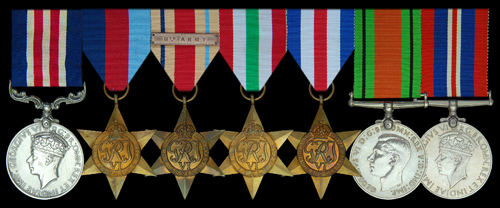
Auction: 8016 - Orders, Decorations, Medals & Militaria
Lot: 292
The Important ´1942, Western Desert´ Immediate M.M. Group of Seven to Sergeant H. White, One of the Original Members of L Detachment, Later 1st S.A.S. Regiment, Who Served with his Unit with Distinction in Sicily, Italy, Occupied France-as Part of Operation Houndsworth with the Maquis, and Over the Rhine; He was Twice Wounded, the Last Occasion Ending his Pre-War Profession as a Full-Back with West Bromwich Albion a) Military Medal, G.VI.R. (T/154976 Cpl. H, White. R.A.S.C.), minor edge bruise b) 1939-1945 Star c) Africa Star, with 8th Army Bar, this loose as issued d) Italy Star e) France and Germany Star f) Defence and War Medals, generally very fine or better, with the following contemporary related items: - Two ´1st S.A.S.´ cloth shoulder titles - Original cloth beret badge - Original Campaign Medal card box of issue - Soldier´s Service and Pay Book - 1st S.A.S. Regiment Certificate of Service, dated 16.11.1945, signed by the Officer Commanding the 1st Battalion - Army Receipt of Payment to recipient in respect of the M.M., dated 10.5.1946; Letter from the Ministry of Pensions, dated 9.11.1946 - Regimental Postcard, signed ´best wishes for the New Year from Harold´ - Small German note book, the front cover annotated ´Notes, Sgt. H. White ´A´ SQDN: 1st S.A.S. Regt.´ - Eight photographs, including one portrait of recipient in uniform, the others representing different periods of his service ranging from his time in the desert to one of him when he was recuperating in hospital, many of these annotated by recipient - Typed Letter from West Bromwich Albion Football Club giving details of recipient´s playing career, dated 13.5.1948 - Several newspaper cuttings, and obituaries (lot) Estimate £ 24,000-28,000 M.M. London Gazette 26.11.1942 No. 154976 Corporal Harold White, Royal Army Service Corps. The Recommendation, signed by David Sterling, states: ´´This NCO has taken part in five raids and has himself destroyed more than 20 aircraft. During the second raid on Tamet Aerodrome Dec 1941 this NCO carried on with his task while visible to the enemy and under heavy fire from automatic weapons. He succeeded eventually in shooting his way out from a position in which he was apparently hopelessly surrounded. It is requested that no details of these operations should be published owing to their secrecy.´´ 154976 Sergeant Harold White, M.M. (1916-82), spent the early part of his life dedicated to Football, a native of the Black Country, he ´´played for Wednesbury Town and Darlaston before signing for Albion about 1938, as full back.´´ (Newspaper Cutting, included in lot refers); the ´´Albion´´ were West Bromwich Albion for whom he was, ´´one of our full-time professional players prior to the war in 1939 and was a regular first team man´´ (typed letter from West Bromwich Albion, included in the lot refers); the outbreak of the Second World War interrupted his promising career, and he enlisted with the Royal Army Service Corps, 24.1.1940; a natural athlete, originally part of Layforce, he started his service with L Detachment, 6.9.1941, the day after ´´Gentleman Jim´´ Almonds arrived at Kabrit, Training Camp, in the Canal Zone; here White would have undergone a severe parachute training regime like no other he would have experienced, with an emphasis on adaptation and survival; he took part in L Detachment´´s first organised raid as part of Operation Crusader, 16/17.11.1941, White was one of Paddy Mayne´´s section, which included Reg Seekings, Corporal Bob Bennett, J.H.M. ´´Lofty´´ Baker, ´´behind Bennett were parachutists Harold White, Royal Army Service Corps, Corporal Geordie White, Royal Scots.....´´ (The Regiment, The Real Story of The S.A.S., M. Asher, refers); the raid did not go well with only 22 of the original force of 62 picked up out of the Western Desert by the Long Range Desert Group, ´´soon after dawn, Mayne´´s section came in.... Mayne had eight men with him - Edward McDonald, Dave Kershaw, Harold White, Bob Bennett, Reg Seekings, Tom Chesworth, Tony Hawkins and Geordie White´´ (Ibid); in December, operating out of Jalo Oasis, L Detachment started upon a series of successful airfield raids, mostly achieved by the use of adapted Lewes bombs as aircraft demolition charges; on the 8th December Paddy Mayne led the first raid on Tamet airfield with seven men, destroying approximately 25 aircraft on the ground and several fuel dumps; on the 27th of the same month Mayne with five men, among them Harold White, returned to Tamet airfield for a second raid (see recommendation); the result of this raid was 27 aircraft, 3 lorries and several fuel dumps all destroyed, when fighting his way out it would appear that White was wounded, as suggested by an article that appeared in the local newspaper when he had written home to his parents to inform them that he was to be awarded the M.M., ´´The news of the award was continued in a letter sent by White to the home of his parents in Wednesbury.... He has written to his parents to say that he is in hospital, but he is well on the way to recovery and he hopes to be back to duty soon´´ (Newspaper Cutting, included in the lot refers); upon his recovery White returned for service with L Detchament, ´´He´´s been places, Crete, North Africa, Sicily, Italy, Normandy, Rhine. These read like proud regimental battle honours of the War just ended. I list them as the individual battle honours of Harold White, M.M., West Bromwich Albion´´s right-back. Harold in turn, has been a commando, a paratrooper and a glider pilot. He was one of the last dozen men to get away from Crete. Then he served in the North African campaign through Sicily to Italy. Next assignment was in the B.L.A. He was over the Rhine before the main assault took place. With his medal ribbons, flashes and badges, Harold is quite a sight.´´ (Cutting included in lot refers); as a newly promoted Sergeant, and as part of the formally renamed L Detachment, then 1st Special Air Service Regiment (which then became the Special Raiding Squadron, 1943), he would have been involved in the landings on Sicily, July 1943, when the S.R.S. captured 2 coastal gun positions and some 300 Italians at Capo Murro Di Porco, followed by the capture of the town of Augusta a few days later; in September and October of the same year the S.R.S. where once again in action, this time in Italy, landing and attacking the coastal towns of Bagnara and Termoli, the latter involved three days of severe fighting, with the loss of 29 men killed when a shell fell on a lorry carrying reserve S.R.S. men to the front line; after action in Italy, White´´s unit returned to North Africa before shortly moving to the UK for new training; the unit was sent to Darvel in Scotland to train for missions in which they would be dropped behind enemy lines on the continent, and then meet and lead the Maquis and French Resistance against the Germans; one of these operations in which White was involved was Operation Houndsworth - this operated in the Morvan Hills, west of Djion for 3 months from, 5.6.1944; Houndsworth´´s patrols covered 6,000 square miles, cut 22 railways, killed or wounded 200 Germans, and reported 30 targets for Allied bombers, an extract from D.I. Harrison´´s These Men Are Dangerous gives insight into an episode involving White which occurred during the operation, ´´They also learned that Captain Bradford had been killed. With Sergeant White, Sergeant McGinn, a French mechanic and one of the maquis, they had set out in a jeep to contact Du Vivier, deciding on the way to contact Captain Chevalier, chef de maquis in the area, who had some information for the S.A.S...... Just after eight in the morning they passed through the village of Lucy, and turned right along a secondary road. They had not gone more than a hundred yards when they came face to face with a German officer and a Sergeant. The officer, not realizing they were British, signalled them to halt. For answer Sergeant White gave them a burst with his guns. Suddenly, round a bend fifteen yards further on, they came on a truck-load of Germans halted at the side of the road. The Germans immediately opened fire. Returning fire, the jeep swept past only to realize, too late, that they were passing a stationary German convoy of considerable size. It was too late to turn back. They decided to shoot their way out. They were now coming under heavy fire from the troops in the trucks and in the fields on either side of the road. Raking the trucks with fire they raced on. Roy Bradford had been wounded in the left arm and the mechanic killed. The situation was desperate but they could only carry on. They were passing the last truck of the convoy when a heavy burst of machine-gun fire hit the jeep, killing Roy and wounding Sergeant White and the maquisard. They managed to get out of sight of the convoy before the jeep packed in. Hearing the Germans running down the road the three survivors, two of them wounded, made a dash for the woods, where they threw off their pursuers.´´; White was discharged from the S.A.S., 16.11.1945, returning home unable to continue his life as a professional footballer with West Bromwich Albion, ´´Unfortunately, injuries received in the services, prevented him playing regularly for us when he came back and eventually brought about his retirement from first class football.... We believe but for these injuries, he would have been an International Footballer, of the top grade.´´ (typed letter from West Bromwich Albion Football Club, included in lot refers).
Sold for
£34,000




